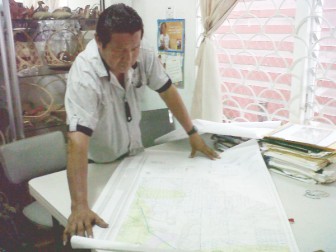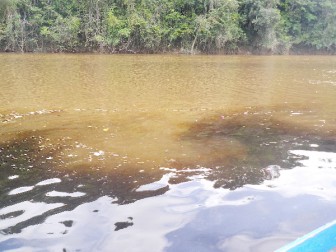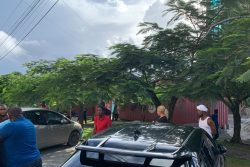-seeking to protect river from pollution, complaints lodged with ministries
Three times this year villagers rushed to their boats, faced off with a gold prospector and rejected letters from officials, a court order and pleas to allow gold mining equipment to pass.
Each time the dredge was forced to return downriver. “The villagers say they are committed to defend the land at any cost because they feel that their rights are being violated,” said Mario Hastings – the leader of Kako, an Akawaio Amerindian community on the banks of the Kako River in Region Seven. “The present situation is very, very serious,” he said.

For the 700 residents of this remote village in the rainforest who are witnessing an increase in gold mining due to high gold prices and experiencing firsthand the resultant pollution of the land and rivers, it is a fight to keep a river they depend on for water and food, pristine and free of the pollution and contaminants that have been visited upon the numerous rivers and streams of the gold fields of the Upper Mazaruni in Region Seven. There are only three rivers in the area that show no discoloration from mining activities, said Hastings.
But now villagers fear that the Kako River might become the next to be polluted and so have resolved to prevent dredges from moving upriver. Mining blocks have been granted on lands upstream but no miner has sought to move to those areas until recently, Hastings said. At present, the dark, clear waters flow silently past Kako village before draining into the discoloured waters of the Mazaruni River.
The differences in the colour of the water in the two rivers were clear and this was observed during a visit to the area by Stabroek News earlier this year.
Hastings said that they learnt earlier this year of plans by a gold and diamond miner to move equipment about 24 miles upstream from the village.
The area is two and a half miles outside the community’s titled land but residents consider that land as traditional land and it is the subject of a court case while some also reside in the area.
The toshao said that before entering the river, the miner early this year met with the village council which objected to any mining activity upstream. He said that there were three main reasons: the village was never informed that the river was opened for mining; the ongoing court case which began in 1998 and involves the same land and; “we didn’t want any mining because that is the only river used (to get) potable water and fish.”
However, he said, the miner, armed with letters from the Ministry of Amerindian Affairs and the Guyana Geology and Mines Commission notifying the village of her intention to move her mining equipment to her river claim, began moving the dredge upriver on July 29. He said that villagers approached her and stopped her from moving the equipment before she could get far.
Hastings said that on August 21, in the company of two police officers and mines officers, the miner re-entered the Kako River with the dredge and began moving upstream.

He said that she did not inform the council of her intention this time but residents upon noticing what was occurring signalled the mines officers and informed them of the village’s position and pointed to the court case. The village leader said that after listening to the villagers, the mines officers instructed the miner not to proceed but she did not heed them.
“The people felt they were not respected and jumped in their boats and went after the woman and stopped her from going further,” Hastings said. He said that the villagers spoke with the miner who eventually returned to Kamarang to inform the GGMC headquarters of the situation.
The toshao said he was in Georgetown at the time and he visited the Ministry of Amerindian Affairs, the Ministry of Natural Re-sources and the Environment and the GGMC. He said he lodged a statement of complaint at the GGMC and was informed that instructions were sent telling the miner that she must not proceed until further investigations were done. “To date, I have not been informed of any investigation,” the village leader said.
Third attempt
He said that on October 3, the miner made a third attempt to move upriver. She had gained an ex-parte injunction against him as toshao, the village council, the GGMC and the Attorney-General on September 18 and this was granted on September 20, Hastings said. He said that the court order essentially said they were not allowed to stop the miner from moving upstream. Hastings said he was in another part of the area holding meetings when he was informed that the woman was moving her equipment. He said that when he arrived, the villagers had already stopped her from moving farther upstream. He recalled that he spoke with her and said he thought it would be best for her to stop making attempts to move upstream until the court matter was resolved.
The village chief asserted that the village is strongly opposed to any mining upstream of the community. “We believe that the river would be polluted and if we allow this individual, then others will follow,” he said. “We know from experience that Upper [Mazaruni] is a mining area and we would have a lot of impact to our culture, way of life, health,” the village leader said. He said that because of mining activities, the incidence of malaria, dengue and typhoid has increased in the area. He said that they are also experiencing cases of fish dying mysteriously in the rivers and despite an investigation, the results have not been reported to the village and they are not satisfied.
Further, he pointed out that the Kako River is not as deep as the Mazaruni given that it has many rapids and he said that the high-powered boats of the miners, and the tailings from the dredges would disrupt navigation. He added that the miners also do not have any respect for the fishermen and others.
Hastings said he had no confidence that the Amerindian Affairs Ministry would help to resolve the matter because in the letter that the miner showed the council, the minister said that they must cooperate with the miner. “That alone would tell that she is in favour of them rather than trying to help us,” he said. He said he had also met the minister who said that the miner has a legal right to work and if the toshao went against this, he could find himself in trouble in an apparent reference to legal proceedings.
Hastings said the letter from the GGMC said that the agency was satisfied that the mining would not have a health impact on the community “which was a grave insult to us.” Hastings said that at the Ministry of Natural Resources, he met the permanent secretary who instructed him to meet the GGMC Commissioner but he met the Chief Mines Officer instead who told him that they would investigate.
The toshao said since the third failed attempt to move upstream, the miner’s equipment has been moored in the Mazaruni River and the villagers say they are committed to defending the land at any cost since they feel their rights are being violated. He pointed to a recent court decision with regard to renewal of mining permits which was in favour of miners and said that it “is just an example of what can happen to us as a people, not only to Upper Mazaruni but all other Amerindian communities that are fighting for their land to be recognized.”
Hastings said that he also raised the matter at the last National Toshaos Council meeting in early August and was told that he would get a response in two weeks but to date has not seen one.
It is alarming, he said, that Guyana is pushing a low carbon development strategy and the land they have been protecting for years “are being given to other people who would only destroy the forest.”








